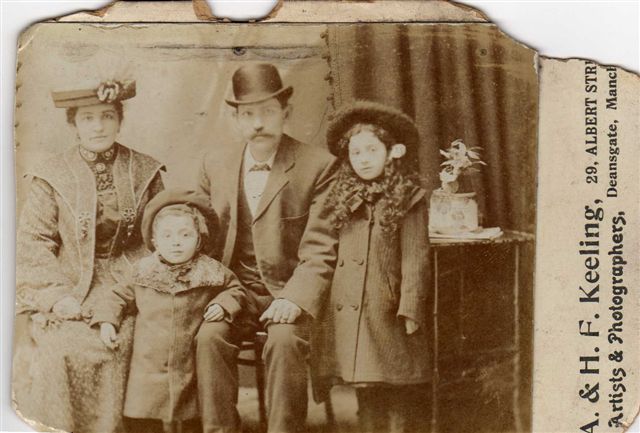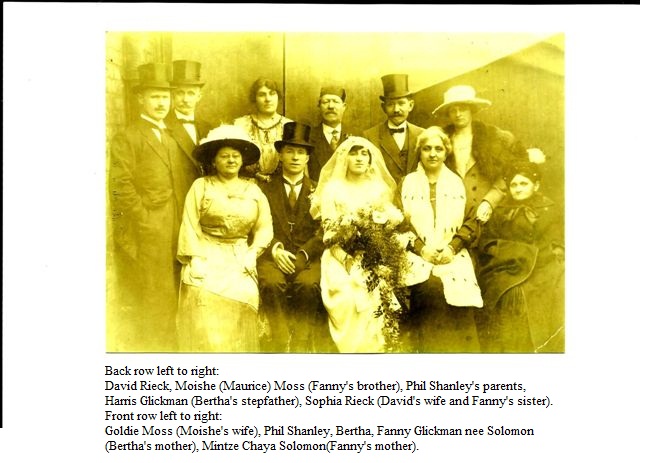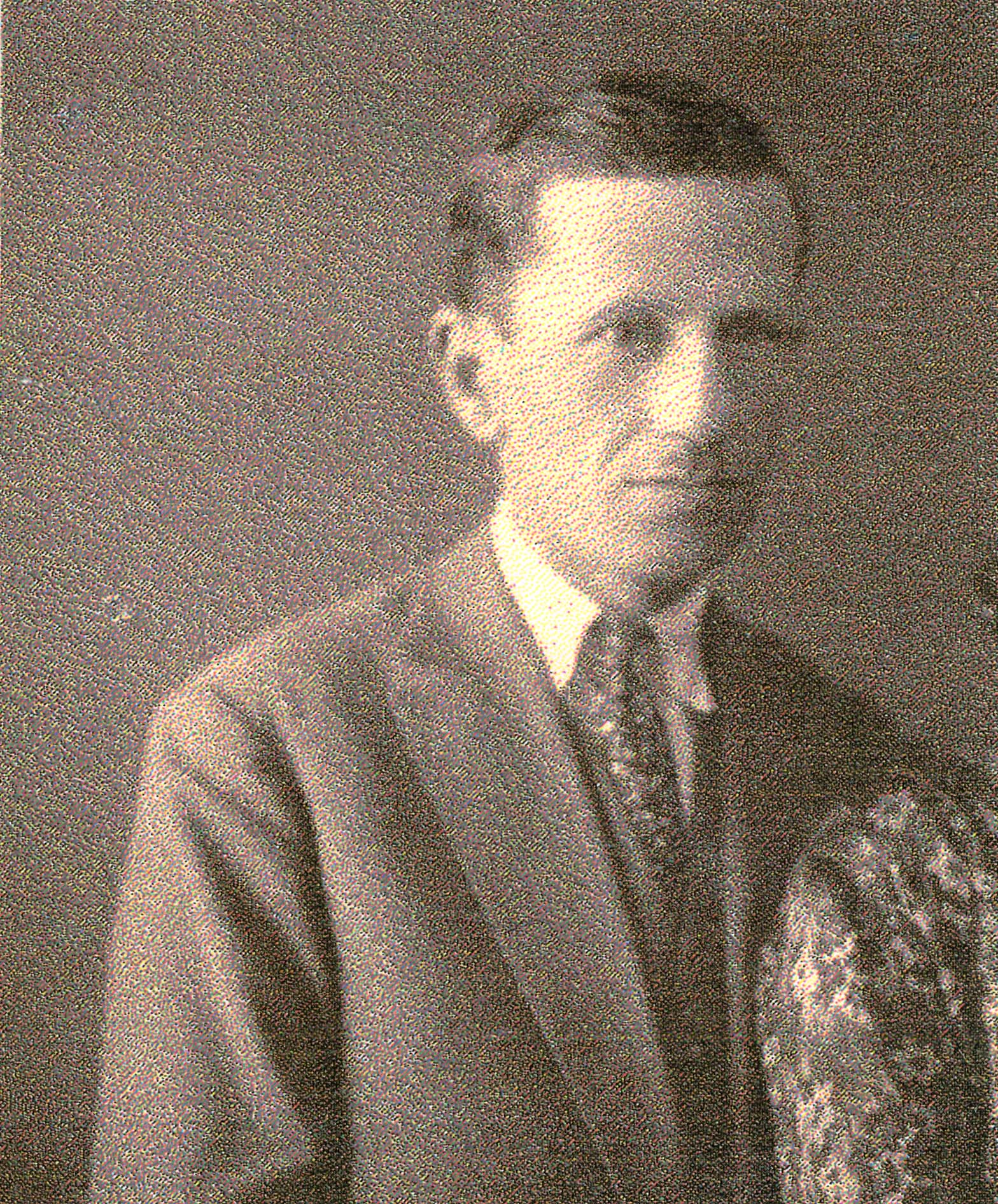GOING
BACK TO RADUNANENI
1976
by Henry S. Glickman Ph. D.

Thanks
to
Sue Lever (nee Glickman) for the retyping &
editing.
To view photos taken by Dr. Henry Glickman on his
visit, click links: Cemetery
and Views
To navigate back
to this page after viewing the photos, click on the
link adjacent to the photos "Glickman in Family Album"
MY GRANDFATHER WAS born in Raducaneni, in the
Moldavian region of Rumania, about 100 years ago. He left
the village in the last decade of the nineteenth century and
made his way to Manchester, England, where he married and
had five sons. He did not prosper economically and died
quite young several years before I was born.
My parents lived in Manchester for a few years
after their marriage, then moved to Glasgow where I was born
and grew up. After finishing secondary school, I spent six
years in Israel and for the past ten years I have been
living in New York. Last summer, I took my wife and two
small children to visit Raducaneni.
I had always pictured the Eastern European
shtetl as being cold and bleak so it came as something of a
surprise to find that Raducaneni and the surrounding
countryside were very pleasant. We approached the village
from the north, climbing gradually from a marshy plain,
through fields covered with vines and maize. Wild flowers in
a variety of bright colors grew profusely along the
roadside. Then from the top of a rise we came upon the
village, lying in a shallow valley. There were rows of
stucco cottages on both sides of the road, with tiled roofs
and high wooden fences. The steeple of the Catholic church
rose above the other buildings. At first we could see no
movement but when we drove into the village we found a group
of people gathered casually round a public well at the side
of the road. The sun was shining and the village looked warm
and peaceful. Somehow I had never imagined Raducaneni in
summertime.
THE IMAGE I had of what the shtetl looked like
was obviously connected with what I imagined it was like to
live there. I knew that there were people who referred to it
as Der Heim (home) but to me it represented an austere and
confining existence. The danger to life and property was not
the only thing that made living conditions harsh. There were
also the rigors of an implacable religious fervor and a
narrow intellectualism. It is true that there was a strong
sense of community but to me it seemed like the
uncomfortable cohesiveness of people huddling together
against the storm. These cultural traits had survived the
shtetl itself; I had observed them directly in
others and in my own experience I had not fully outgrown
them.
I had never seen a pogrom but the physical
insecurity suffered by my ancestors in Eastern Europe was
vivid in my mind and there was ample historical
documentation. For most of the nineteenth century Rumania
was dominated by Tsarist Russia with its reactionary
Orthodox church. The treaty of Berlin in 1878 recognised the
independence of Rumania on condition that freedom of
religion would be guaranteed for all citizens. But there was
no relief for the Jews. Russian-inspired pogroms and
persecution increased in intensity in the ensuing years and
Jews were officially proclaimed to be aliens subject to
legal discrimination. In 1895, an Anti-Semitic League was
organised with the blessings of the Rumanian government.
Religious passions were inflamed against the Jews in
Moldavia and other regions by the revival of the Blood
Libel.
It was hard to associate these horrors with the
tranquil, rather lethargic village which we found on the day
of our visit. The people at the public well seemed curious
and friendly when we approached them and I could detect no
trace of distrust or hostility when I put the two questions
I had learnt in Rumanian: “Where is the Jewish synagogue?”
and “Where is the Jewish cemetery?” The postman, whom I
approached first, seemed puzzled by my inquiry. He indicated
that he did not know and continued on his way, pushing his
bicycle before him. But the rest of the group discussed the
matter among themselves with lively interest. They seemed to
be telling us that we would not be able to find what we were
looking for, that there were no Jews in Raducaneni. They
were open-faced, genial people who were obviously trying to
be helpful. Then one of the women suddenly had an idea. She
pointed back up the road and asked us to squeeze her into
our car so that she could take us to talk to the Jew
Moskowitz.
The parents and grandparents of this woman were
my grandfather’s neighbors. He must have known days like
this one: beautiful weather, friendly faces and his native
village lying in a fertile valley. I had long been aware of
the dark side of the shtetl tradition and how it had
influenced my view of the world. But now it seemed to me
that the shtetl and its tradition had light as well as shade
which should, perhaps, have been obvious from the start.
THERE WAS HISTORICAL support for such a
view. In the early nineteenth century the Hussite Protestant
church in Moldavia welcomed and protected Jewish residents,
many of whom came from neighboring Bessarabia. Jewish
doctors and merchants were prosperous and highly esteemed;
Jewish schools were established reflecting different shades
of orthodoxy. Raducaneni itself had a long history of
accepting Jewish settlers. It was founded in 1838 and almost
until the end of the century had a Jewish majority. At the
time my grandfather left the village, in the midst of a wave
of Jewish emigration, only about half of its 3,000
inhabitants were gentiles. In 1907, during a local uprising
against the government, peasants from neighboring villages
invaded Raducaneni to attack and plunder the Jewish
community. The Roman Catholic inhabitants fought back to
protect the Jews and succeeded in repelling the marauders.
All this, of course, against a background of continual
persecution; and it scarcely needs to be added that things
did not go well for the Jews who remained in Moldovia until
the Second World War. But the promise and the possibility of
acceptance by the gentiles, or by some of them, was a
persistent feature of the Jewish experience.
Nor was this ambiguity, and the ambivalence it
produced, entirely alien to my own personal experience. I
knew what it was to be an outsider looking wistfully in. I
knew the yearning for acceptance and belonging and its
obverse, a defiant pride in being different. And it went
beyond relations with gentiles. I was an outsider in Israel,
too (which did not prevent me from developing bonds of
affection for the country and its people). One can always
find a minority with which one can identify oneself. I had
detected an interesting kind of figure-ground reversal in my
social perceptions. When reading the New York times, for
example, I sometimes felt mildly self-conscious about being
a British citizen and I found myself hoping that the paper
would speak well of my country; but when I was with other
British citizens I might feel a little defensive about
subscribing to the New York Times and hope the others would
give the paper their approval. Being Jewish was, indeed, a
state of mind.
IT TURNED OUT that Moskowitz was not from
Raducaneni at all but he was the only Jew who could be found
in the village. He was the manager of the local agricultural
cooperative which appeared to be responsible for the
gathering and marketing of all the produce of the village.
Moskowitz was a man in his fifties, dressed much like the
other employees around him. He spoke to us in fluent
Yiddish. Raducaneni, he told us, had five synagogues before
the war but now there were no synagogues and no Jews.
As Moskowitz recalled it, conditions were difficult in the
old days and men had to live by their wits, which suited
some of them very well and went hard with many others.
Moskowitz arranged for one of the villagers to
take us to the Jewish cemetery. We certainly could never
have found it on our own. Only the main road running through
the centre of the village was paved; once we left it we were
on winding mud paths interspersed with numerous ruts and
bumps. We yielded the right of way to geese, hens and pigs
wandering freely between the cottages. Finally, we left the
residential part of the village and started up a steep
narrow path between cultivated fields. Before long we had to
abandon the car and continue on foot to the top of the hill.
It seemed like a strenuous journey for a funeral cortege.
Looking back, we could see the whole village stretched out
before us.
An abandoned concrete building at the edge of a
field marked the entrance to the cemetery. The field itself
was covered with the long green leaves of a maize crop and
showed no sign of graves. Beyond it we passed through a
cherry orchard, then emerged into a broad expanse across
which were scattered dozens, perhaps hundreds, of grey
unpolished gravestones. The terrain was irregular. Parts of
the area were planted with maize, other parts with grass and
weeds; and there was a group of men with scythes who seemed
to be clearing one section for cultivation. From where we
stood, in the midst of the gravestones, the village was
completely hidden from view. Rolling farm country surrounded
us on all sides.
Jews have always sought secluded, private
places for the burial of their dead. It is as if they were
aware of how the dead can interfere and wished to be given a
chance to take a fresh look at their problems and deal with
them in their own way. It is not for the dead, says a
Talmudic dictum, to contradict the living. They are not
entitled to do so, but the Jews know that it happens every
day. In Raducaneni the dead had been well concealed
and soon the remaining graves might completely disappear; I
looked in vain for the graves of my own great-grandparents.
But I had not forgotten them. I wondered whether they would
be pleased, or surprised, if they could see me standing
there amongst them.
WE SAW GRAVES dating back to the turn of the
century and some as late as the 1950s. Most were simple
things, identifying only the first name of the deceased and
the first name of his or her father; they were written in
Hebrew, occasionally with a few words in German. A woman
called Zlatteh, the daughter of Meir, who died in 1906, was
described as elderly, chaste and esteemed. A crude
seven-branched candelabra was engraved superficially at the
top of her stone. Other stones were without ornamentation or
expressions of sorrow or praise; simply the fact of death.
Several epitaphs began with a line from Lamentations: “My
eye, my eye, runs down with water.”
A few stones conveyed a greater sense of pride
and prestige. Low relief pilasters and festoons adorned one
of the stones, which was crowned with a star of David. “Here
lies Mr. Meir Jacob son of Israel Zvi of blessed memory,
known as Mr. Altir, an expert ritual slaughterer and
examiner, and a fine cantor, from 5620 to 5665 (1860-1905),
in this town of Raducaneni. May his soul be bound up with
everlasting life.” Mr. Altir, and his cantorial abilities,
must have been well known to my grandfather.
One of the humblest stones was in the shape of
an obelisk. A small stone tablet had been superimposed on it
and the lettering was cramped and uneven. I could not make
out the first name but the inscription said that she was
“the daughter of Samuel Naphtali, killed by accursed
murderers on the fifth of Tammuz 5691 (1931).” The
word “accursed” was bigger than the rest and took up a whole
line. A few feet away was an identical stone whose
inscription recorded the murder of a man who died five days
after the woman. His epitaph did not use the word “accursed”
and ended with an abbreviation meaning: ”His soul is in
Paradise.” The tablets on both stones were completely
filled. It must have been a bitter choice: to bless the dead
or to curse their murderers.
There was no way of knowing from the
gravestones who committed these crimes or why but the Jewish
experience suggests that the perpetrators had a reason. It
might have been their religious enthusiasm or nationalistic
fervor, or a passion for freedom or equality, or rage
against injustice. The precise ideology of the murderers
didn’t matter to the Jews of Raducaneni because they
believed that there was always going to be some cause or
crusade which was impervious to reason and which justified
the killing of Jews. For my part, I did not share the view
that Jews were uniquely persecuted. There was enough
prejudice to go around. But I did retain a fear of and
revulsion for all forms of absolutism and unreasoning
fanaticism. And, unreasonably enough, I sometimes found
myself responding to the intolerance I deplored with angry
intolerance of my own.
WHEN WE RETURNED to the cooperative, everybody
seemed very busy. Fresh fruit was being boxed, loaded and
transported out of the village. Some of the workers came
over to get a better look at us and they impressed me as
being a cheerful, good-natured group of people. The woman
who had first led us to the cooperative was waiting for us
and greeted us warmly. When our ten-month-old baby
began to fret, she picked him up and calmed him by singing
what sounded like a Russian lullaby. Moskowitz was there
too. At his request, someone brought out a basin-full of
ripe red cherries which were poured into a bag to supply us
for the road. We were very pleased by this gesture and the
good feelings seemed to be shared by all the people round
about us.
Then we were on our way, driving slowly back
through the center of the village. At the outskirts there
were two youths on the road who turned round as we
approached. They had shaven heads, greyish complexions and
bony cheeks. There was something sinister about them to my
mind, and their passing glance as we drove by gave me a
slight chill. It was like a warning to me not to accept at
face value the good impressions--- or the bad ones--- which
I had received during my visit to the village. And I
wondered whether generations of threats and uncertainty had
bequeathed to me the suspicion that things, and people,
including myself, were not necessarily what they seemed to
be.
We drove south from Raducaneni along the west
bank of the River Prut which marks the border between
Russian Bessarabia and Moldavia. It was a broad, muddy
river with wooded islands on the middle. We ate the cherries
as we travelled; they were juicy with a pungent, slightly
bitter flavour, which I found very agreeable.
IN THE OLD days, smugglers with family
connections on both sides of the border used to cross the
River Prut with their merchandise. Further north in Polish
Galicia, the Baal Shem Tov, founder of the Hassidic
movement, would repair to the banks of the Prut for solitary
meditation. He taught his disciples to serve the Lord with
joy---an inner, insular joy, which could be achieved by a
community that desensitized itself to the blows and the
blandishments of the outside world.
Rural Moldavia had not changed much in the past
hundred years. The scenes we passed on our journey through
the countryside were quiet and undramatic. A man
plodded behind a horse-drawn plough which he guided
unsteadily across a field. An old woman carried a heavy
wooden yoke across her shoulders, balancing a pail of water
at each end. People stood waiting at a public well with
assorted receptacles for water; there was no queue and
no-one was in a hurry. And a stork which was nesting on the
thatched roof of a cottage stretched its wings and lifted
itself slowly into the air.
I did not think I would like to live there
today, or that I would have liked it a hundred years
earlier. But if a man had left Moldavia for Manchester, I
thought I could understand his feeling that something
valuable had been left behind. The gentle landscape must
have had something to do with it. Something made my
grandfather feel that the love and the fear and the hate he
had known in the shtetl had an inner harmony or meaning and
the memory of his experience ought to be preserved.
|








